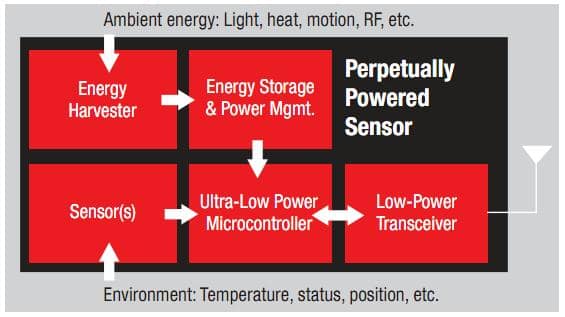Energy Harvesting Wireless Sensors
投稿人:电子产品
2011-06-30
EnOcean Alliance helps ensure interoperability of increasingly sophisticated sensors and controls
According to the U.S. Department of Energy, buildings consume 39 percent of the energy and 74 percent of the electricity produced annually in the United States. For building owners, “going green” can mean not only reduced energy costs and tax incentives, but also improved tenancy rates and higher per-square-foot revenue as prospective commercial and residential tenants demand improved energy efficiency. Underlying green programs, building automation systems (BAS) provide the measurement and control capabilities needed to enhance energy efficiency in buildings of all shapes and sizes. At the periphery of these systems, BAS designers increasingly rely on wireless sensor nodes that employ energy harvesting techniques to cut the cord for both communications and power in sensor networks.
BAS installations comprise multi-tiered networks with sensors and controls linked at the lowest physical-interface level. Using wireless communications, BAS integrators can place sensors where needed, but cutting the cord for sensor nodes means using communications other than power-hungry Wi-Fi or ZigBee transceivers.
“Temperature control in large enclosed spaces – such as goods warehouses or aircraft hangars – presents a huge challenge to conventional technologies. As such, this type of environment is very expensive to heat or cool and uncomfortable to work in,” said Marc Dugré, president of Regulvar, a building automation systems integrator. “Innovative wireless technology can provide the answer.”
In fact, the combination of low-power circuitry and energy-conserving power management methods enable engineers to create “perpetually” powered sensor nodes able to harvest required energy from ambient sources including heat, vibration and even RF signals (see Figure 1). Besides their benefit in eliminating sensor maintenance in conventional BAS installations, these zero-battery sensors hold promise for long-term structural health monitoring: For the first time, structural engineers can cost-effectively monitor load bearing members typically buried within concrete and insulation.

Engineers can explore energy harvesting node development using complete platforms such as Texas Instruments’ eZ430-RF2500 microcontroller-based development kit, Microchip’s XLP 16-bit energy harvesting development kit and Advanced Linear Devices EH300/EH301 series energy harvesting modules, among others.
In the past, the greatest challenge in deploying more sophisticated sensing technology has been dealing with integration within heterogeneous sensor networks comprising devices from multiple vendors. Today, however, integration has become easier thanks to the broad market acceptance of interoperability standards established by the EnOcean Alliance, a consortium of 170 companies addressing various aspects of building automation including chip makers, module manufacturers, software developers and system integrators.
The EnOcean industry standards define low-level data communications protocols. The EnOcean radio protocol (ERP) defines a data “telegram” with duration less than 1 ms to enable reliable, low-power communications. For example, engineers can use this approach to control a battery-free radio switch with a sub-millisecond telegram that consumes uses only about 50 μW of energy. Different peripheral devices use ERP telegrams to communicate data using payloads defined in a series of EnOcean Equipment Profiles. EnOcean-compliant devices operate at sub-gigahertz frequencies considered optimal for limited range building-automation sensor and control applications (see Fig. 2 - enocean_bands.jpg). These devices use the 868-MHz band in Europe and the Middle East and the 315-MHz band in the U.S. and Far East.

The combination of different bandwidth usage and specific gateway protocols ensures that EnOcean Alliance-compliant devices can coexist with existing communication networks such as Wi-Fi and ZigBee as well as with the installed base of BAS standards including ASHRAE’s BACnet, LonMark’s LON and the KNX Associations’s KNX protocol. For example, EnOcean standards define a BACnet gateway that recognizes various BACnet objects. Using EnOcean ambient-light-powered temperature sensors linked to a central BACnet system, an elementary school in Lacolle, Quebec, Canada, cut energy costs by 30%. The installation itself took just seven days and cost significantly less than a comparable cabled solution.
Overall, EnOcean claims installation of compliant devices in over 100,000 buildings. Its showpiece is perhaps the Torre Espacio in Madrid, Spain – the world’s tallest, wireless sensor-automated building with about 4,200 EnOcean-interoperable devices serving building operations over the tower’s 56 floors and 56,259-m2 floor space. According to the Alliance, the application of the EnOcean-compliant energy harvesting wireless sensor network saved 20 miles of cable, 1.3 tons of copper and 3 tons of pVc in this Space Tower. EnOcean says this technology reduced costs for installation and will result in little or no maintenance costs as well as saving about 42,000 batteries over the next 25 years.
免责声明:各个作者和/或论坛参与者在本网站发表的观点、看法和意见不代表 DigiKey 的观点、看法和意见,也不代表 DigiKey 官方政策。






